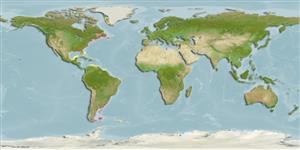Polychaeta |
Spionida |
Spionidae
Environment: milieu / climate zone / ระดับความลึก / distribution range
นิเวศวิทยา
; กร่อย; ระดับความลึก 14 - 18 m (อ้างอิง 112705). Temperate
Atlantic Ocean and the Arctic.
Length at first maturity / ขนาด / Weight / Age
วัยเจริญพันธุ์: Lm ? range ? - ? cm
Found in littoral and sublittoral sediments (Ref. 1314). An infaunal species in sandy substrate, commonly on Zostera sp. beds (Ref. 95819). In the Vainameri, north-eastern Baltic Sea, inhabits rocky, silty sand and clay sediment types (Ref. 95753), and under Furcellaria lumbricalis mats (Ref. 95891). An opportunistic species linked to the reduced survival of native benthic species in the Baltic Sea (Ref. 95891).
Life cycle and mating behavior
วัยเจริญพันธุ์ | การสืบพันธุ์ | การวางไข่ | Eggs | ความดกของไข่ | Larvae
Members of the class Polychaeta are mostly gonochoric (sexual). Mating: Females produce a pheromone attracting and signalling the males to shed sperm which in turn stimulates females to shed eggs, this behavior is known as swarming. Gametes are spawned through the metanephridia or body wall rupturing (termed as "epitoky", wherein a pelagic, reproductive individual, "epitoke", is formed from a benthic, nonreproductive individual, "atoke"). After fertilization, most eggs become planktonic; although some are retained in the worm tubes or burrowed in jelly masses attached to the tubes (egg brooders). Life Cycle: Eggs develop into trocophore larva, which later metamorph into juvenile stage (body lengthened), and later develop into adults.
Hill, M., R. Baker, G. Broad, P.J. Chandler, G.H. Coop, J. Ellis, D. Jones, C. Hoyland, I. Laing, M. Longshaw, N. Moore, D. Parrott, D. Pearman, C. Preston, R.M. Smith and R. Waters 2005 Audit of Non-native Species in England. English Nature Research Reports Number 662. 82 p. (อ้างอิง 1314)
IUCN Red List Status
(อ้างอิง 130435: Version 2025-1)
CITES status (อ้างอิง 108899)
Not Evaluated
CMS (อ้างอิง 116361)
Not Evaluated
Threat to humans
Human uses
| FishSource |
เครื่องมือ
ข้อมูลเพิ่มเติม
Life cycleการสืบพันธุ์วัยเจริญพันธุ์ความดกของไข่การวางไข่EggsEgg developmentLarvae Human RelatedStamps, coins, misc.
แหล่งที่มาจากอินเตอร์เน็ต
Estimates based on models
Price category
Unknown.
